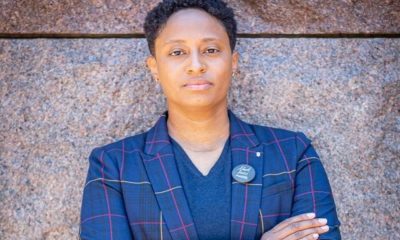Living
A dream fulfilled
MLK memorial, years in the making, resonates with LGBT community

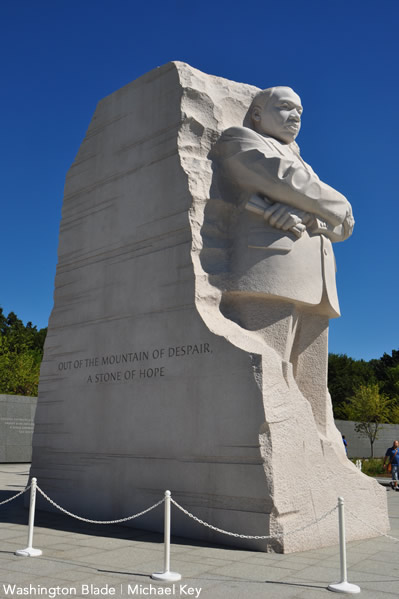
The civil rights movement pioneered by Martin Luther King, Jr., has inspired many leaders of the LGBT movement. (Washington Blade photo by Michael Key)
(UPDATE: The MLK Memorial dedication ceremony has been postponed due to Hurricane Irene. It is expected to be rescheduled for September or October.)
When a tribute to the Rev. Martin Luther King, Jr. is dedicated this weekend, it will mark more than the addition of a new monument to Washington, D.C.’s landscape.
It will symbolize the civil rights leader’s success.
The stone likeness rises as the first monument to a man of color on the National Mall, 48 years after King described his then ground-breaking dream, and in a nation where — at least ostensibly — much of that dream has been realized.
The movement was a model for countless others, including the LGBT rights push, which has shared nonviolence tenets and even leaders like gay, black activist Bayard Rustin.
Yet most similarities end there.
While fruits of the civil rights movement are evident in modern America — apparent in a widening black middle class and a black first family in the White House, for instance — the gay rights movement’s successes have been slower coming.
Same-sex marriage rights remain tenuous and limited to a handful of states; despite hate crime legislation, the threat of violence continues to deny many gays and lesbians a basic sense of safety in their hometowns.
As the nation prepares to welcome King to the National Mall, community leaders share their outlook on the LGBT movement with the Washington Blade — from a California group using civil unrest to humanize the struggle; to the partner of late gay and civil rights icon Bayard Rustin working to keep his ideals alive; to former NAACP leader Julian Bond, who uses his status as a key historic civil rights figure to promote the LGBT rights struggle as a modern civil rights fight.
They point to entrenched faith-based bigotry, and even a lack of movement cohesion, as obstacles. But each believes that by using King’s model of continued struggle, the LGBT dream of full equality can be achieved.
Images of change
The Rev. Martin Luther King, Jr. sitting in an Alabama jail cell. Firefighters battering blacks with powerful jets of water. Jeering whites pouring condiments over the heads of stoic lunch counter protesters.
They’re images that moved activist Robin McGehee, as a child growing up in Jackson, Miss.
And today as executive director of GetEqual, she organizes demonstrations to create actions and images she hopes will drive home the plight of gay and lesbian men and women just as powerfully. An absence of such visual tools encouraged McGehee to form the group, with offices in Berkeley, Calif., and Washington, D.C., in January 2010.
“We had that in reference to the AIDS movement in ACT-UP, and fighting for adequate health care. But in reference to a full civil rights fight for equality, I couldn’t think of one iconic action,” she said.
The group has orchestrated more than 40 actions in the last year, including one in which military veterans handcuffed themselves to the White House fence to protest “Don’t Ask, Don’t Tell.”
The group honed use of such actions at the Highlander Research and Education Center, a New Market, Tenn., center that trained members of the original civil rights movement. McGehee and other LGBT equality activists underwent training at the historic center in January 2010.
“Not until you can give literal imagery to that discrimination do people really resonate or get it,” McGehee said.
Yet despite mirroring the earlier movement’s successful tactics, activists’ success in mainstreaming LGBT rights remains light years behind that of racial equality — something McGehee blames on entrenched religious bigotry.
“We’ve gotten into a moment where people are using the Bible as a weapon,” said McGehee, pointing out that while religious rhetoric once justified slavery and racism, cultural changes eventually erased such thinking. “… I don’t think we’ve jumped that hurdle with regard to gays.”
McGehee is encouraged, however, by more subtle success in incorporating gays and lesbians socially. Just a few years after Ellen DeGeneres thought twice about coming out on TV, realistic portrayals of gays and lesbians are common on TV.
“In time,” she said, “I think we’re gonna get there.”
A life of service
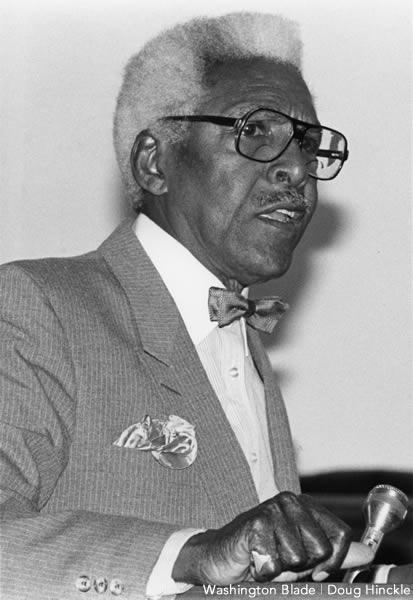
The former partner of Bayard Rustin said the gay civil rights leader would be happy with the arrival of marriage equality, but would have pushed for it in all 50 states. (Washington Blade archive photo by Doug Hinckle)
Walter Naegle had certainly heard of Bayard Rustin, the relentlessly active civil rights agitator who gained as much notoriety for his efforts to win black equality as for his open homosexuality.
But on the day he ran into the civil rights legend on a New York City corner in April 1977, he didn’t recognize him: Rustin wasn’t carrying his trademark walking stick.
“When he gave me his name, I knew,” said Naegle, whose chance meeting with Rustin lead to a 10-year relationship that ended only when the activist died in 1987.
More than two decades later, Naegle keeps Rustin’s ideals alive, working with filmmakers to promote “Brother Outsider,” a portrayal of Rustin’s story, executing his estate and generally overseeing the use of his image.
He believes Rustin’s courage, openness and tireless work — he was in his 70s and still agitating when he died — have helped make him resonate as an icon of the human rights movement.
By the time Naegle met Rustin, the activist had long been a legend. Rustin had worked with A. Philip Randolph to strengthen relationships between blacks and labor unions, but was perhaps best known for his role organizing the 1963 March on Washington.
He’d also become a gay rights icon before it was fashionable: Rustin was essentially outed in 1953 when he was arrested on a “morals charge,” yet he refused to deny the charges or his sexual orientation.
“He didn’t have to hide anything,” he said. “He was just going to be who he was and let the chips fall where they may.”
Rustin would pay the price for that openness.
“Whenever he would rise to a certain level, particularly in the African-American civil rights movement but also in other movements, something would happen and someone would try to chop him down,” Naegle said.
Nonetheless, “He was not defeated. He didn’t turn around and stop his activism — he just worked on the sidelines.”
Rustin remained active with several organizations, including the A. Philip Randolph Institute and the United States Holocaust Memorial Council, at the time of his death.
Years later, his story still has the power to inspire. Naegle said a book of his letters is slated for publication in March, in time for what would have been Rustin’s 100th birthday.
Naegle believes his partner would have been “heartened” to see marriage equality happen in even one state. But he wouldn’t have been satisfied with limited success.
“It’s fine to have these victories in urban areas,” Naegle said. “But people all over the country should be entitled to the same thing.”
“Gay and lesbian rights are not ‘special’ rights”
Julian Bond’s new fight

Former NAACP Chair Julian Bond likens the modern LGBT movement to the push for black civil rights in the ‘60s. (photo courtesy of wikimedia.org)
Where others may see conflict between the black and gay rights agendas, Julian Bond sees similarities.
Both groups struggle against bigotry based on personal characteristics. Both are entitled to basic rights by the same Constitution. And both benefit from each others’ successes.
Indeed, he argues, “People of color ought to be flattered that our movement has provided so much inspiration for others — that it has been so widely imitated,” Bond, who works as an adjunct professor at American University, told the Blade.
The man who has worn many hats as a Georgia lawmaker and leader with both the Southern Poverty Law Center and the NAACP, has more recently directed his outspoken energies to the conflict between civil rights and gay rights advocates.
It’s a particularly touchy dispute. Old school civil rights leaders and even some black gays bristle at LGBT activists’ use of King’s rhetoric to promote their agenda as a modern civil rights movement. Some site racial divisions within the LGBT movement, and argue that discrimination faced by gays isn’t as harsh as that faced by blacks.
Yet for Bond, there isn’t much of a dispute: The two groups must lock arms.
“Many gays and lesbians worked side by side with me in the ’60s civil rights movement. Am I now to tell them thanks for risking life and limb helping me win my rights, but they are excluded because of a condition of their birth?” he said. “That they cannot share now in the victories they helped to win?”
Bond has lent his outspoken rhetoric and organizational skills to many causes over the years.
While a student at Morehouse College, in Atlanta, in the ’60s, he helped organize the Student Nonviolent Coordinating Committee, he was the first president of the SPLC and was board chairman of the National Association for the Advancement of Colored People from 1998 to 2010.
He’s become one of the most vocal mainstream voices in the movement to promote equal treatment for gays and lesbians, going as far as to boycott the funeral of King widow Coretta Scott King in 2006 after the services were arranged at an anti-gay church.
In July, Bond spoke at an NAACP forum discussing gay and lesbian issues in the black community, featuring openly gay black comedian Wanda Sykes and CNN anchor Don Lemon.
“People of color carry the badge of who we are on our faces. But we are far from the only people suffering discrimination,” Bond said. “Sadly so do many others. They deserve the law’s protections and civil rights too.”
Bond’s comments stand in contrast to the black community’s historically conservative stance on gay issues.
Yet he said one need only look at the personal examples set by the lauded civil rights leaders to see whether such thinking is in line with King’s dream.
“We cannot know what Dr. King would have thought about today’s GLBT movements,” Bond said. “But if we consider the prominent role his widow, Coretta Scott King, occupied in speaking out on GLBT rights, it is hard to believe that he would not have done the same.”
Autos
Sporty sedans: BMW 530i xDrive, Mercedes AMG CLA 3
Tariffs are here and the result is financial chaos
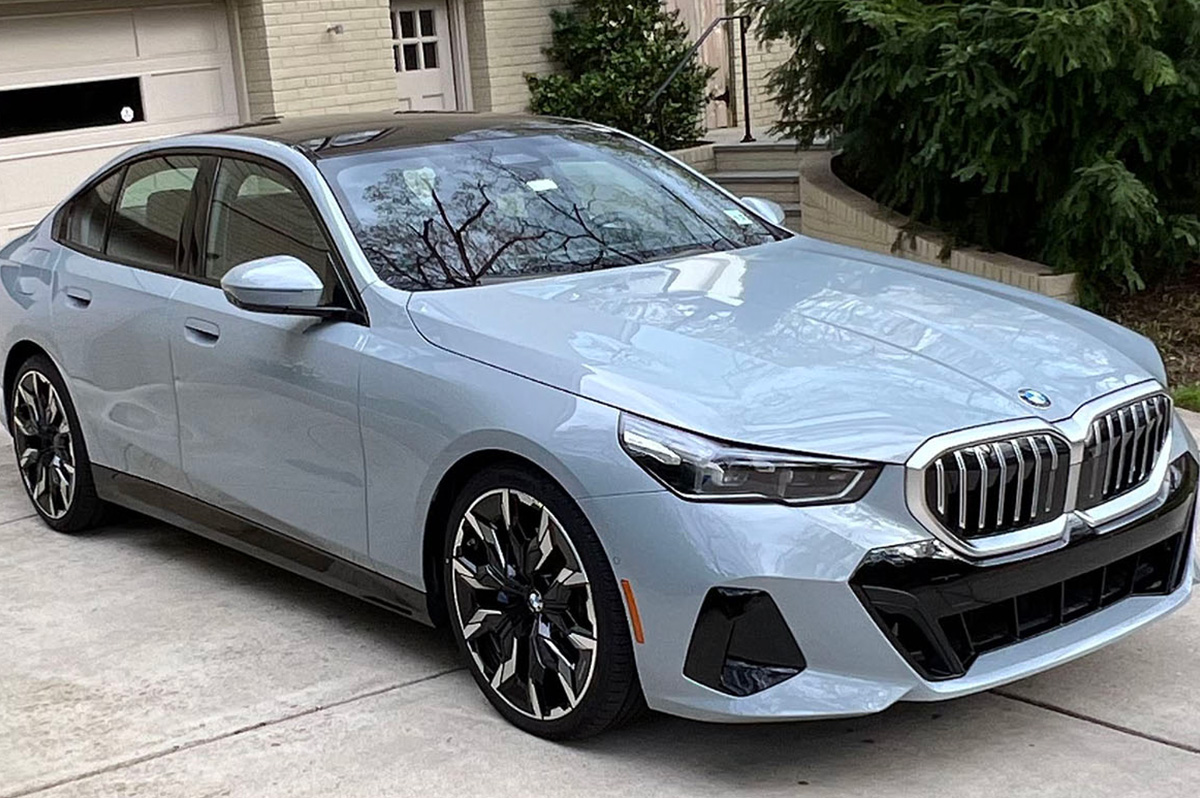
It’s official: Tariffs are here, and the result is financial chaos.
So, what to do when purchasing a new vehicle? If you need one in the not-so-distant future, buy sooner (like yesterday) rather than later. Expect prices to rise quickly, as inventory dwindles, demand soars, and automaker incentives evaporate. Of course, if a new ride isn’t a priority for at least a year or three, then hold off until the dust settles.
But for those of you looking for new wheels now, I recently drove two sport sedans that were a pleasant reprieve from the usual plethora of pickups, minivans, and SUVs.
BMW 530i xDRIVE
$63,000
MPG: 28 city/35 highway
0 to 60 mph: 5.5 seconds
Cargo space: 18.4 cu. ft.
PROS: Rakish looks. Race-car vibe. Rock-star amenities.
CONS: Rad-but-quirky infotainment system. Rich price.
IN A NUTSHELL: Classic good looks, from the iconic grille and swept-back headlights to chiseled side panels and a tasteful tush. For a gearhead like me, the BMW 530i xDrive — completely redesigned last year — is as rapturous as Michelangelo’s David. Everything here is in proportion, from the design to the drivetrain, which — along with a gutsy 255-hp turbo and all-wheel drive — helps deliver a divine experience behind the wheel. Even better, my test car came equipped with the heavenly M-Sport Package: 21-inch wheels, athletic suspension, and assorted styling upgrades.
A tech-laden cabin is outfitted with a sparkly 12.3-inch digital instrument cluster and 14.9-inch touchscreen infotainment system. With the windshield head-up display and a slew of knobs and toggle switches in the center console and on the steering wheel, I wondered if this is how it feels to pilot the Space Shuttle. There is even a back-lit interaction bar with touch-sensitive controls to adjust vent direction and other climate control settings.
All this gadgetry takes some getting used to, but the overall effect is dazzling. While a 12-speaker Harman Kardon stereo comes standard, I was jammin’ to the 16-speaker Bowers & Wilkins premium audio. Of course, such options add up quickly (on my test car, the extras totaled $13,000).
Just how fun is this car? In my favorite episode of “Hacks,” sassy Jean Smart drives a rockin’ Rolls Royce Wraith. Trust me, this four-door BMW is every bit the badass as that $300,000 super coupe.
MERCEDES AMG CLA 35
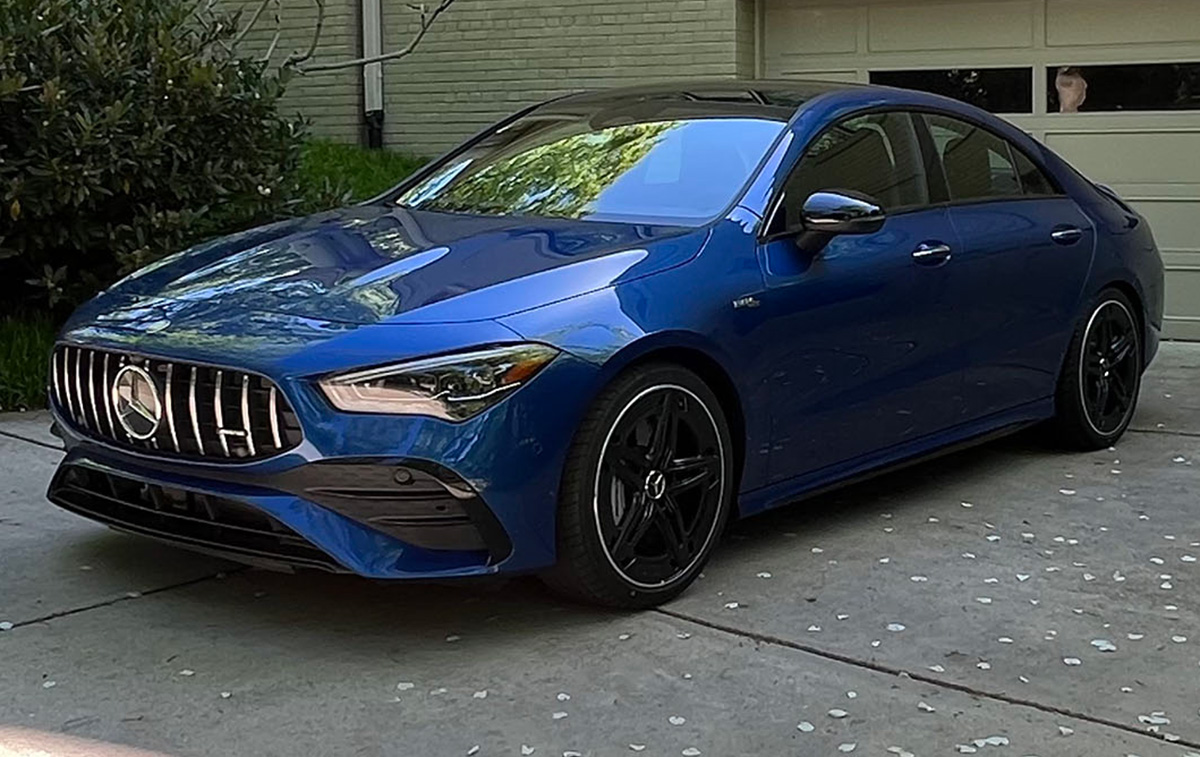
$58,000
MPG: 22 city/29 highway
0 to 60 mph: 4.8 seconds
Cargo space: 11.6 cu. ft.
PROS: Slick styling. Spiffy cabin. Sublime seats.
CONS: Smallish trunk. So-so rear headroom and legroom.
IN A NUTSHELL: Need a smaller sedan that’s just as marvy as the midsize BMW i530? Look no further than the compact Mercedes CLA-Class, which is 14 inches shorter. That’s a benefit when jockeying for parking or navigating rush hour.
Another plus: This is Mercedes’s least expensive sedan, available in three trim levels. All come with the same potent turbo but in varying power levels. The base model starts at $46,000, but I tested the first of two high-performance versions: the AMG CLA 35, which costs $12,000 more. You can open your wallet even further to snag the $67,000 AMG CLA 45.
But why bother? The AMG CLA 35 is plenty quick — faster than the BMW i530 — and boasts sport-tuned brakes, deft handling and a gritty-sounding exhaust system. The laundry list of standard features includes all-wheel drive, automated parking, gobs of the latest safety gizmos and even something called “safe-exit assist,” which prevents passengers from opening a door into traffic or speeding cyclists.
The interior is pure Mercedes, with top-notch materials, customizable ambient lighting and Burmester surround-sound audio. The overall layout—sleek and modern, but with elegant stitching in the seats and on the door panels and dashboard—is comfortable and user-friendly. Digital displays and touchscreens are similar to what’s in the BMW i530, just smaller.
Size matters, of course, which is why this vehicle’s shorter length can be a blessing but also a curse, especially when trying to squeeze passengers with longer legs into the backseats. And the dramatically sloped roofline, attractive from the outside, limits the amount of rear headroom and cargo space. Thank the automotive gods for panoramic sunroofs, which—at least for anyone in the front seats—makes this cabin feel surprisingly spacious.
Real Estate
Spring updates to sell your home for pride and profit
Consider new landscaping, power washing, creative staging

Selling a home is a big deal for anyone, but for members of the LGBTQ+ community, it comes with unique considerations—from finding affirming professionals to ensuring your home is represented in a way that reflects your values. Whether you’re a first-time gay home seller or a seasoned LGBTQ+ homeowner looking to move up, maximizing your home’s value is key to a successful and empowering sale.
Here’s how to prepare your home, your mindset, and your real estate strategy to get the most value—financially and emotionally—from your home sale.
1. Start with an LGBTQ+-Friendly Real Estate Agent
Before diving into renovations or staging, make sure your agent truly understands your needs. A gay-friendly or LGBTQ+-affirming real estate agent brings more than just market expertise—they bring cultural competence, safety awareness, and a network that supports you throughout the selling process.
At GayRealEstate.com, you can find experienced, vetted LGBTQ+ real estate agents who have been proudly serving the community for over 30 years. Working with someone who shares or supports your identity ensures your selling journey is respectful, inclusive, and effective.
2. Enhance Curb Appeal—With a Welcoming Vibe
The outside of your home is the first impression a potential buyer gets. Make it count—especially for LGBTQ+ buyers looking for a home that feels safe and welcoming.
- Fresh landscaping: Add colorful flowers, neatly trimmed shrubs, or low-maintenance greenery to appeal to eco-conscious buyers.
- Update the entrance: A new front door, stylish lighting, or even a rainbow doormat can make your home feel like a safe space from the start.
- Clean and repair: Power wash the exterior, touch up paint, and make any necessary repairs to gutters, windows, or siding.
3. Stage with Intention and Inclusivity
Home staging can add thousands to your sale price. But beyond the usual decluttering and neutral palettes, think about how your space tells a story—and who it’s telling it to.
- Create a warm, inclusive feel: Subtle touches like LGBTQ+ art, books, or even coffee table magazines can show off your personality and affirm the space for queer buyers.
- Depersonalize—but don’t erase: You don’t need to hide your identity to appeal to buyers. Let your home feel lived in and loved—while still being a blank canvas others can imagine themselves in.
- Highlight multi-use areas: Home offices, gender-neutral nurseries, or flex spaces resonate with LGBTQ+ families and professionals.
4. Update Kitchens and Bathrooms Strategically
These rooms matter most to buyers—and even small updates can yield big returns.
- Kitchen: New cabinet hardware, a fresh backsplash, and modern lighting can elevate the entire room without a full remodel.
- Bathroom: Replace old fixtures, re-caulk tubs and sinks, and add plush towels and inclusive décor.
- Energy-efficient upgrades: Touchless faucets, smart appliances, or low-flow toilets are not only trendy—they signal sustainability, which matters to LGBTQ+ buyers.
5. Make Your Home More Energy Efficient
LGBTQ+ homebuyers often prioritize sustainability. These updates not only reduce energy bills but make your home more marketable.
- Install a smart thermostat (like Nest or Ecobee)
- Upgrade insulation or windows
- Consider solar panels (especially in sun-drenched regions like California or Florida)
Bonus: You may qualify for state or federal tax credits, which can be a great selling point.
6. Know and Advocate for LGBTQ+ Housing Rights
Although housing discrimination is illegal under the Fair Housing Act, it still happens. As an LGBTQ+ seller, be aware of your rights—and those of potential buyers.
- Avoid steering or bias: Even with good intentions, make sure you’re not inadvertently influencing who views or buys your home based on identity.
- Work with affirming professionals: From inspectors to lenders, choose partners who support inclusive practices.
- Report discrimination: If you or a buyer encounters bias, report it to HUD or your local housing authority.
7. Price Your Home Right—and Market It Smartly
Setting the right price is essential to maximizing value. Your LGBTQ+-friendly agent can run a comparative market analysis, considering current trends and buyer demographics.
- Leverage LGBTQ+ real estate networks: Promote your home through platforms like GayRealEstate.com to reach an audience that understands and values your space.
- Use inclusive language in listings: Avoid gendered terms or heteronormative assumptions. Instead of “his and hers closets,” use “dual walk-ins” or “double closets.”
- High-quality photos and video tours: Showcase your home with professional, visually inclusive marketing that appeals to diverse buyers.
8. Consider Timing and Local LGBTQ+ Trends
Selling during WorldPride or just before local LGBTQ+ events may boost visibility. Also consider if you’re in or near an LGBTQ+ friendly city or neighborhood.
Not sure which areas are top destinations? GayRelocation.com tracks and shares the best cities for LGBTQ+ homebuyers, helping you tap into motivated buyers.
Final Thought: Sell with Confidence—and Community
Selling your home isn’t just about getting top dollar—it’s about closing a chapter with pride and integrity. When you center your values, work with LGBTQ+ affirming experts, and prepare your home with purpose, you’re not just maximizing your home’s value—you’re creating an empowering experience for yourself and the next owner.
Whether you’re buying, selling, or both—GayRealEstate.com is your trusted partner in every step of your journey. With a nationwide network of gay and lesbian realtors, decades of experience, and deep community ties, we ensure your home transition is safe, smart, and full of pride.
GayRealEstate.com is the nation’s leading online platform connecting LGBTQ+ home buyers and sellers with LGBTQ+ friendly real estate agents, ensuring a safe and supportive experience.
Scott Helms is president of GayRealEstate.com. To find an agent or learn more, visit GayRealEstate.com, GayRelocation.com or call 1-888-420-MOVE.
Real Estate
Navigating DMV real estate market during political unrest
Reductions in federal employment have introduced uncertainties

The Washington, D.C.-Maryland-Virginia (DMV) region has long been recognized for its robust housing market, underpinned by the presence of the federal government and a diverse economic landscape. Recent massive reductions in federal employment have introduced uncertainties, yet the area continues to offer compelling reasons for prospective homebuyers, particularly within diverse communities.
While the federal government has traditionally been a significant employer in the DMV, the region has proactively diversified its economic base. Sectors such as technology, professional services, education, and healthcare have expanded, mitigating the impact of federal job cuts. This diversification fosters some economic resilience, which offers our area a semblance of protection against the impending unknowns that we currently face. Nothing can shield real estate entirely; however, our area tends to survive these types of changes better than other parts of the country.
Despite concerns over federal layoffs, the DMV housing market has demonstrated notable stability. Analyses indicate that the number of active listings, sold properties, and median sales prices have remained steady on a year-over-year basis. This steadiness suggests that the market is adapting to changes without significant disruption.
Furthermore, while there has been a slight increase in home listings, this trend aligns with typical seasonal variations and does not solely reflect federal employment changes. The luxury property segment, in particular, continues to thrive, indicating sustained interest and investment in the region.
The DMV region is renowned for its cultural and demographic diversity, with areas like Montgomery County, Md., being among the most ethnically diverse in the nation. This inclusivity extends to various communities, including LGBTQ individuals, fostering a welcoming environment that enhances the area’s appeal. Even though the current administration is fostering anti-diversity ideology, I remain confident that our LGBTQ community will continue to thrive even as these destructive forces work against us.
Local governments within the DMV have implemented policies aimed at promoting affordable housing and preventing displacement, particularly in the wake of economic shifts. Initiatives like the Douglass Community Land Trust in Washington, D.C., exemplify efforts to maintain housing affordability and support community stability.
Additionally, jurisdictions such as Montgomery County have longstanding Moderately Priced Dwelling Unit (MPDU) programs that require developers to include affordable housing in new residential developments. These policies contribute to socioeconomically mixed neighborhoods, benefiting diverse populations.
Despite Elon Musk’s brandishing of a chainsaw to the federal workforce, our real estate market continues to thrive. The DMV region maintains its appeal. Economic diversification, market stability, commitment to diversity and inclusion, and progressive housing policies collectively contribute to an environment that supports and attracts diverse communities. Prospective homebuyers can find reassurance in the region’s resilience and ongoing efforts to foster an inclusive and vibrant community. These are only a few among the many reasons to have a positive outlook while considering real estate options in our area.
It is important to consider working with brokerages, brokers, agents, lenders and title companies who align with our community and our objectives. Not all LGBTQ agents work for brokerages that support or understand the needs of the members of our community. Do your research and find out who has donated money to what political causes. Now more than ever we must support members of our community to protect our way of life and our very existence.
Stacey Williams-Zeiger is president/principal broker of Zeiger Realty Inc. Reach her at [email protected].
-

 State Department4 days ago
State Department4 days agoHIV/AIDS activists protest at State Department, demand full PEPFAR funding restoration
-

 Brazil4 days ago
Brazil4 days agoUS lists transgender Brazilian congresswoman’s gender as ‘male’ on visa
-
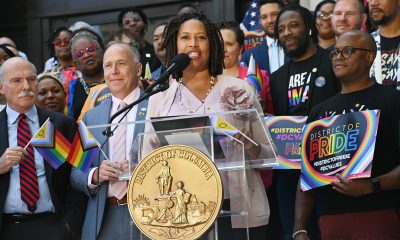
 District of Columbia4 days ago
District of Columbia4 days agoCapital Pride wins $900,000 D.C. grant to support WorldPride
-

 Mexico3 days ago
Mexico3 days agoGay couple claims Puerto Vallarta wedding venue discriminated against them



